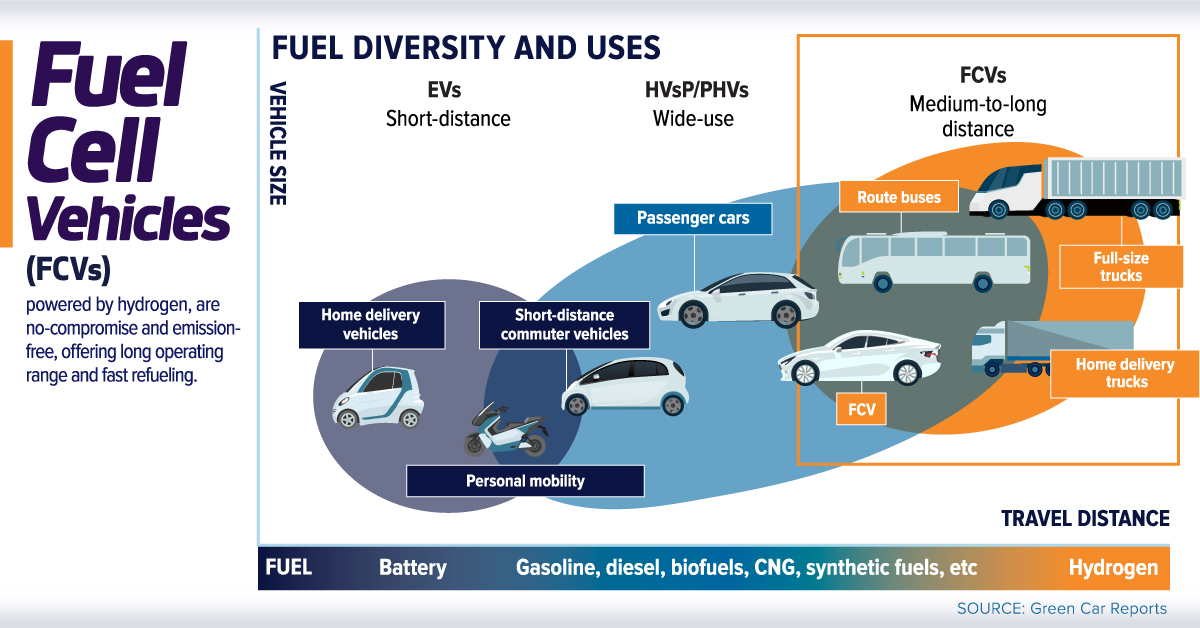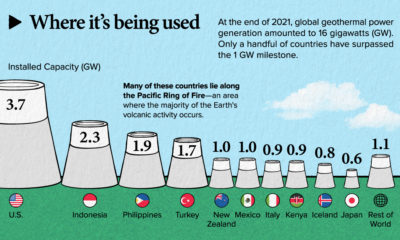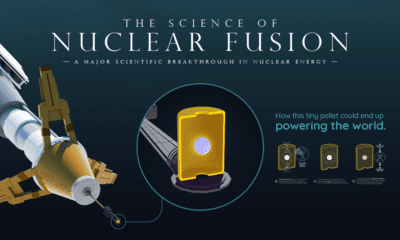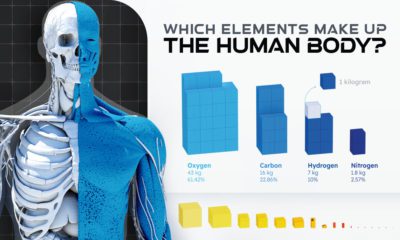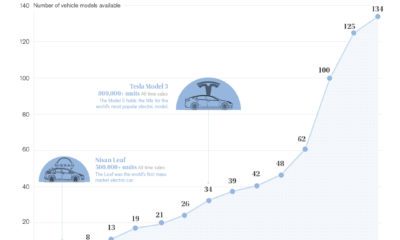Energy
The Evolution of Hydrogen: From the Big Bang to Fuel Cells
It all started with a bang…the big bang!
The explosive power of hydrogen fueled a chain reaction that led to the world we have today.
Now this power is being deployed on Earth to supply the energy needs of tomorrow.
Visualizing the Power of Hydrogen
Today’s infographic comes to us from the Canadian Hydrogen and Fuel Cell Association, and it outlines how hydrogen and fuel cell technology is harnessing the power of the universe to potentially fuel an energy revolution.

What is Hydrogen, and How’s it Used?
With one proton and one electron, hydrogen sits at the very beginning of the periodic table.
Despite hydrogen being the most common molecule in the universe, it is rarely found in its elemental state here on Earth. In fact, almost all hydrogen on the planet is bonded to other elements and can only be released via chemical processes such as steam reforming or electrolysis.
There are five ways hydrogen is being used today:
- Building heat and power
- Energy storage and power generation
- Transportation
- Industry energy
- Industry feedstock
However, what really unleashes the power of hydrogen is fuel cell technology. A fuel cell converts the chemical power of hydrogen into electrical power.
Hydrogen Unleashed: The Fuel Cell
In the early 1960’s, NASA first deployed fuel cells to power the electrical components of the Gemini and Apollo space capsules. Since then, this technology has been deployed in everything from the vehicle you drive, the train you take, and how your favorite products are delivered to your doorstep.
Nations around the world are committing to build hydrogen fueling stations to meet the growth in adoption of fuel cell technology for transportation.
Hydrogen: A Green Energy Solution
Hydrogen fuel and fuel cell technology delivers green solutions in seven ways.
- Decarbonizing industrial energy use
- Acting as a buffer to increase energy system resilience
- Enabling large-scale renewable energy integration and power generation
- Decarbonizing transportation
- Decarbonizing building heat and power
- Distribution energy across sectors and regions
- Providing clean feedstock for industry
According to a recent report by McKinsey, hydrogen and fuel cell technology has the potential to remove six gigatons of carbon dioxide emissions and employ more than 30 million people by 2050, all while creating a $2.5-trillion market.
This is technology that can be deployed today, with the potential to transform how we live and power our economies in a sustainable way.
Energy
The World’s Biggest Nuclear Energy Producers
China has grown its nuclear capacity over the last decade, now ranking second on the list of top nuclear energy producers.

The World’s Biggest Nuclear Energy Producers
This was originally posted on our Voronoi app. Download the app for free on Apple or Android and discover incredible data-driven charts from a variety of trusted sources.
Scientists in South Korea recently broke a record in a nuclear fusion experiment. For 48 seconds, they sustained a temperature seven times that of the sun’s core.
But generating commercially viable energy from nuclear fusion still remains more science fiction than reality. Meanwhile, its more reliable sibling, nuclear fission, has been powering our world for many decades.
In this graphic, we visualized the top producers of nuclear energy by their share of the global total, measured in terawatt hours (TWh). Data for this was sourced from the Nuclear Energy Institute, last updated in August 2022.
Which Country Generates the Most Nuclear Energy?
Nuclear energy production in the U.S. is more than twice the amount produced by China (ranked second) and France (ranked third) put together. In total, the U.S. accounts for nearly 30% of global nuclear energy output.
However, nuclear power only accounts for one-fifth of America’s electricity supply. This is in contrast to France, which generates 60% of its electricity from nuclear plants.
| Rank | Country | Nuclear Energy Produced (TWh) | % of Total |
|---|---|---|---|
| 1 | 🇺🇸 U.S. | 772 | 29% |
| 2 | 🇨🇳 China | 383 | 14% |
| 3 | 🇫🇷 France | 363 | 14% |
| 4 | 🇷🇺 Russia | 208 | 8% |
| 5 | 🇰🇷 South Korea | 150 | 6% |
| 6 | 🇨🇦 Canada | 87 | 3% |
| 7 | 🇺🇦 Ukraine | 81 | 3% |
| 8 | 🇩🇪 Germany | 65 | 2% |
| 9 | 🇯🇵 Japan | 61 | 2% |
| 10 | 🇪🇸 Spain | 54 | 2% |
| 11 | 🇸🇪 Sweden | 51 | 2% |
| 12 | 🇧🇪 Belgium | 48 | 2% |
| 13 | 🇬🇧 UK | 42 | 2% |
| 14 | 🇮🇳 India | 40 | 2% |
| 15 | 🇨🇿 Czech Republic | 29 | 1% |
| N/A | 🌐 Other | 219 | 8% |
| N/A | 🌍 Total | 2,653 | 100% |
Another highlight is how China has rapidly grown its nuclear energy capabilities in the last decade. Between 2016 and 2021, for example, it increased its share of global nuclear energy output from less than 10% to more than 14%, overtaking France for second place.
On the opposite end, the UK’s share has slipped to 2% over the same time period.
Meanwhile, Ukraine has heavily relied on nuclear energy to power its grid. In March 2022, it lost access to its key Zaporizhzhia Nuclear Power Station after Russian forces wrested control of the facility. With six 1,000 MW reactors, the plant is one of the largest in Europe. It is currently not producing any power, and has been the site of recent drone attacks.
-

 Real Estate2 weeks ago
Real Estate2 weeks agoVisualizing America’s Shortage of Affordable Homes
-

 Technology1 week ago
Technology1 week agoRanked: Semiconductor Companies by Industry Revenue Share
-

 Money1 week ago
Money1 week agoWhich States Have the Highest Minimum Wage in America?
-

 Real Estate1 week ago
Real Estate1 week agoRanked: The Most Valuable Housing Markets in America
-

 Business2 weeks ago
Business2 weeks agoCharted: Big Four Market Share by S&P 500 Audits
-

 AI2 weeks ago
AI2 weeks agoThe Stock Performance of U.S. Chipmakers So Far in 2024
-

 Misc2 weeks ago
Misc2 weeks agoAlmost Every EV Stock is Down After Q1 2024
-

 Money2 weeks ago
Money2 weeks agoWhere Does One U.S. Tax Dollar Go?

